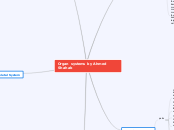Organ systems by Ahmed Shahab
Digestive system
Esophagus: The muscle tissue contract and relax without conscious thought, the movement is controlled by nerve tissue.
Stomach: Main function for the stomach is to hold food and the process of digestion, nerves in the stomach signal when we have had enough to eat.
Intestine: The intestine has cells that produce mucus, the intestine contain smooth muscle that contract and relax without our conscious thought.
Mouth: The mouth is the beginning of the digestive tract; and, in fact, digestion starts here when taking the first bite of food. Chewing breaks the food into pieces that are more easily digested, while saliva mixes with food to begin the process of breaking it down into a form your body can absorb and use.
Digestion begin in the mouth with chewing and ends in the small intestine. As food passes through the GI tract, it mixes with digestive juices, causing large molecules of food to break down into smaller molecules. The body then absorbs these smaller molecules through the walls of the small intestine into the bloodstream, which delivers them to the rest of the body. Waste products of digestion pass through the large intestine and out of the body as a solid matter called stool.
Respritory system
parts
Mouth (Oral Cavity) + Nose (Nasal Cavity): Air is inhaled through these two places, the oral cavity can inhale more air since it is bigger, but the nasal cavity warms and filters the air as it passes through it.
Pharynx (Throat): Air enters and descends making it's way to the Trachea, but prior to that, the air passes through something called ciliated epithelial cells, which are sort of like a filter for the air.
Trachea (Windpipe): Air enters and passes through here.
Bronchi (Singular: Bronchus): The Trachea branches off into the bronchi, which deliver the air to the lungs.
Lungs: Provides oxygen to capillaries and exhales CO2.
Diaphragm: Muscle responsible for the contractions of the lungs to allow air in and out.
Alveoli: Component of lung where gaseous exchange takes place.
How it works together
The air enters through the mouth or nasal cavity, where it passes through the pharynx or more commonly known as the throat. In the throat is where it is filtered by the ciliated epithelial cells. Then the air travels through the trachea where it is separated into two branches called the bronchi that branch out through the lungs into tiny air sacs called alveoli that are surrounded by capillaries. Since the alveoli have thin membranes they allow gasses such as oxygen and carbon dioxide to diffuse in and out of the blood stream.
Circulatory system
parts
Heart: it pumps the blood to all body parts in a regular, and constant beat.
Blood vessels: there are three types of them and its main job is to transport the blood. Veins: it carries blood towards your heart. Arteries: it carries blood away from the heart. Capillaries: are tiny blood vessels with very thin walls that enables the exchange of gasses, nutrients, and wastes between the blood and the body tissues.
Blood: it is a type of connective tissue that circulates throughout all parts of the body caring food, water, and oxygen to all body parts and exchanging carbon dioxide with nutrients and supply them to the cells through small arteries called capillaries
how it works together
Your arteries carries blood that has oxygen, and food to your(right)half or part of your heart then as your heart contracts it pumps blood to all your body parts. Your blood then delivers all the nutrients to your cells through the capillaries, and exchange it with carbon dioxide. Then the blood vessels carry the blood that has carbon dioxide and waste products to the other part of your heart (left) and the heart contracts again to pump it to other organs like (lungs) to get rid of it.
Musculoskeletal System
parts
Ligaments: Ligaments are tough, elastic connective tissues that hold bones together at the joints. They are made up mostly of long fibres of collagen.
Bones: The internal structure or frame of the body.
Muscles: Muscle tissue consists of bundles of long cells called muscle fibres that contain specialized proteins.
How it works together
The muscular system can be broken down into three types of muscles: skeletal, smooth and cardiac. The muscles in the body support movement, help maintain posture, and circulate blood and other substances throughout the body.
Nervous system
parts
Brain: The coordination center of sensation and intellectual and nervous activity.
Spinal Cord: A bundle of nerve fibers and associated tissue that is enclose in the spine.
Ganglia: A structure containing a number of nerve cell bodies.
Nerves: Fibers of sensory and motor neurons
How it works together
The nervous system works by sending neurons. The brain, the control centre of the body sends these neuron to anywhere in your body. Some neurons are special. For example, sensory neurons go to the eyes, ears, nose and tongue because they are most of your senses.
